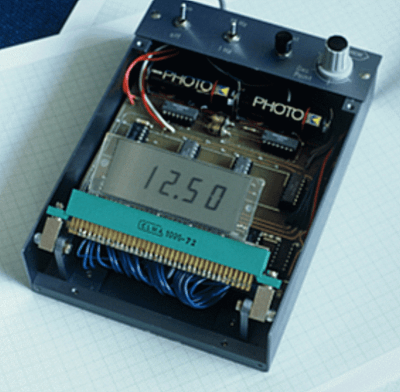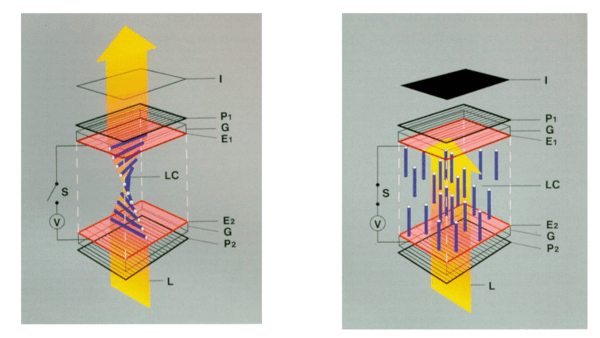Twisted nematic field effect

The twisted nematic effect (TN-effect) was a main technology breakthrough that made LCDs practical. Unlike earlier displays, TN-cells did not require a current to flow for operation and used low operating voltages suitable for use with batteries. The introduction of TN-effect displays led to their rapid expansion in the display field, quickly pushing out other common technologies like monolithic LEDs and CRTs for most electronics. By the 1990s, TN-effect LCDs were largely universal in portable electronics. In the meantime, many applications of LCDs are using alternatives to the TN-effect such as in-plane switching (IPS) or vertical alignment (VA).
Description
The twisted nematic effect is based on the precisely controlled realignment of liquid crystal molecules between different ordered molecular configurations under the action of an applied electric field. This is achieved with little power consumption and at low operating voltages.

The illustrations to the right show both the OFF and the ON-state of a single picture element (pixel) of a twisted nematic light modulator liquid crystal display operating in the "normally white" mode, i.e., a mode in which light is transmitted when no electrical field is applied to the liquid crystal.
In the OFF state, i.e., when no electrical field is applied, a twisted configuration (aka helical structure or helix) of nematic liquid crystal molecules is formed between two glass plates, G in the figure, which are separated by several spacers and coated with transparent electrodes, E1 and E2. The electrodes themselves are coated with alignment layers (not shown) that precisely twist the liquid crystal by 90° when no external field is present (left diagram). If a light source with the proper polarization (about half) shines on the front of the LCD, the light will pass through the first polarizer, P2 and into the liquid crystal, where it is rotated by the helical structure. The light is then properly polarized to pass through the second polarizer, P1, set at 90° to the first. The light then passes through the back of the cell and the image, I, appears transparent.
In the ON state, i.e., when a field is applied between the two electrodes, the crystal re-aligns itself with the external field (right diagram). This "breaks" the careful twist in the crystal and fails to re-orient the polarized light passing through the crystal. In this case the light is blocked by the rear polarizer, P1, and the image, I, appears opaque. The amount of opacity can be controlled by varying the voltage. At voltages near the threshold, only some of the crystals will re-align, and the display will be partially transparent. As the voltage is increased, more of the crystals will re-align until it becomes completely "switched". A voltage of about 1 V is required to make the crystal align itself with the field, and no current passes through the crystal itself. Thus the electrical power required for that action is very low.
To display information with a twisted nematic liquid crystal, the transparent electrodes are structured by photo-lithography to form a matrix or other pattern of electrodes. Only one of the electrodes has to be patterned in this way, the other can remain continuous (common electrode). For low information content numerical and alpha-numerical TN-LCDs, like digital watches or calculators, segmented electrodes are sufficient. If more complex data or graphics information have to be displayed, a matrix arrangement of electrodes is used. Obviously, the voltage controlled addressing of matrix displays, such as in LCD-screens for computer monitors or flat television screens, is more complex than with segmented electrodes. These matrix LCDs necessitate integration of additional non-linear electronic elements into each picture element of the display (e.g., thin-film diodes, TFDs, or thin-film transistors, TFTs) in order to allow the addressing of individual picture elements without crosstalk (unintended activation of non-addressed pixels).
History
RCA research
In 1962, Richard Williams, a physical chemist working at RCA Laboratories, started seeking new physical phenomena that might yield a display technology without vacuum tubes. Aware of the long line of research involving nematic liquid crystals, he started experimenting with the compound p-azoxyanisole which has a melting point of 116 °F (47 °C). Williams set up his experiments on a heated microscope stage, placing samples between transparent tin-oxide electrodes on glass plates held at 125 °F (52 °C). He discovered that a very strong electrical field applied across the stack would cause striped patterns to form. These were later termed "Williams domains".[1] The required field was about 1,000 volts per centimeter, far too high for a practical device. Realizing that development would be lengthy, he turned the research over to physicist George Heilmeier and moved on to other work.
In 1964, RCA's George H. Heilmeier along with Louis Zanoni and chemist Lucian Barton discovered that certain liquid crystals could be switched between a transparent state and a highly scattering opaque one with the application of electrical current. The scattering was primarily forward, into the crystal, as opposed to backscattering towards the light source. By placing a reflector on the far side of the crystal, the incident light could be turned on or off electrically, creating what Heilmeier dubbed dynamic scattering. In 1965 Joseph Castellano and Joel Goldmacher, organic chemists, sought crystals that remained in the fluid state at room temperature. Within six months they had found a number of candidates, and with further development, RCA was able to announce the first liquid crystal displays in 1968.[1]
Although successful, the dynamic scattering display required constant current flow through the device, as well as relatively high voltages. This made them unattractive for low-power situations, where many of these sorts of displays were being used. Not being self-lit, LCDs also required external lighting if they were going to be used in low-light situations, which made existing display technologies even more attractive in overall power terms. A further limitation was the requirement for a mirror, which limited the viewing angles. The RCA team was aware of these limitations, and continued development of a variety of technologies.
One of these potential effects had been discovered by Heilmeier in 1964. He was able to get organic dyes to attach themselves to the liquid crystals, and they would stay in position when pulled into alignment by an external field. When switched from one alignment to the other, the dye was either visible or hidden, resulting in two colored states called the guest-host effect. Work on this approach stopped when the dynamic scattering effect had been demonstrated successfully.[1]
TN-effect
Another potential approach was the twisted-nematic approach, which had first been noticed by French physicist Charles-Victor Mauguin in 1911. Mauguin was experimenting with a variety of semi-solid liquid crystals when he noted that he could align the crystals by pulling a piece of paper across them, causing the crystals to become polarized. He later noticed when he sandwiched the crystal between two aligned polarizers, he could twist them in relation to each other, but the light continued to be transmitted. This was not expected. Normally if two polarizers are aligned at right angles, light will not flow through them. Mauguin concluded that the light was being re-polarized by the twisting of the crystal itself.[1]
Wolfgang Helfrich, a physicist who joined RCA in 1967, became interested in Mauguin's twisted structure and thought it might be used to create an electronic display. However RCA showed little interest because they felt that any effect that used two polarizers would also have a large amount of light absorption, requiring it to be brightly lit. In 1970, Helfrich left RCA and joined the Central Research Laboratories of Hoffmann-LaRoche in Switzerland, where he teamed up with Martin Schadt, a solid-state physicist. Schadt built a sample with electrodes and a twisted version of a liquid-crystal material called PEBAB (p-ethoxybenzylidene-p'-aminobenzonitrile), which Helfrich had reported in prior studies at RCA, as part of their guest-host experiments.[1] When voltage is applied, PEBAB aligns itself along the field, breaking the twisting structure and the redirection of the polarization, making the cell turn opaque.
Patent battle
At this time Brown, Boveri & Cie (BBC) was also working with the devices as part of a prior joint medical research agreement with Hoffmann-LaRoche.[2] BBC demonstrated their work to a physicist from the US who was associated with James Fergason, an expert in liquid crystals at the Westinghouse Research Laboratories. Fergason was working on the TN-effect for displays, having formed ILIXCO to commercialize developments of the research being carried out in conjunction with Sardari Arora and Alfred Saupe at Kent State University's Liquid Crystal Institute.[3]
When news of the demonstration reached Hoffmann-LaRoche, Helfrich and Schadt immediately pushed for a patent, which was filed on 4 December 1970. Their formal results were published in Applied Physics Letters in 15 February 1971. In order to demonstrate the feasibility of the new effect for displays, Schadt fabricated a 4-digit display panel in 1972.[1]
Fergason published a similar patent in the US on either 9 February 1971[1] or 22 April 1971.[3] This was two months after the Swiss patent was filed and set the stage for a three-year legal confrontation that was settled out of court. In the end, all the parties received a share of what would become many millions of dollars in royalties.
Commercial development of liquid crystal materials
PEBAB was subject to breakdown when exposed to water or alkalines, and required special manufacturing to avoid contamination. In 1972 a team led by George W. Gray developed a new type of cyanobiphenyls that could be mixed with PEBAB to produce less reactive materials.[4] These additives also made the resulting liquid less viscous, thereby providing faster response times, while at the same time making them more transparent, which produced a pure-white color display.
This work, in turn, led to the discovery of an entirely different class of nematic crystals by Ludwig Pohl, Rudolf Eidenschink and their colleagues at Merck KGaA in Darmstadt, called cyanophenylcyclohexanes. They quickly became the basis of almost all LCDs, and remain a major part of Merck's business today.[5]
See also
References
- ↑ 1.0 1.1 1.2 1.3 1.4 1.5 1.6 Joseph Castellano, "Modifying Light', American Scientist, September–October 2006
- ↑ IEEE GHN First-Hand Report by Peter J. Wild of LCD developments at Brown Boveri
- ↑ 3.0 3.1 "Twisted Nematic Liquid Crystal Displays (TN-LCDs), an invention from Basel with global effects", Information, No. 118, October 2005
- ↑ George Gray, Stephen Kelly: "Liquid crystals for twisted nematic display devices", Journal of Materials Chemistry, 1999, 9, 2037–2050
- ↑ "Merck Annual Report, 2004"
- M. Schadt: "Milestones in the History of Field-Effect Liquid Crystal Displays and Materials", Jpn. J. Appl. Phys. 48(2009), pp. 1–9
- Martin Schadt, personal communication, 2006/2007
Further reading
- Joseph A. Castellano: Liquid Gold — The Story of Liquid Crystal Displays and the Creation of an Industry, World Scientific Publishing, 2005
- Peer Kirsch, "100 years of Liquid Crystals at Merck: The history of the future.", 20th International Liquid Crystals Conference, July 2004
- David A. Dunmur and Horst Stegemeyer: "Crystals that Flow: Classic papers from the history of liquid crystals", Compiled with translation and commentary by Timothy J. Sluckin (Taylor and Francis 2004), ISBN 0-415-25789-1, History of Liquid Crystals Homepage
- Werner Becker (editor): "100 Years of Commercial Liquid-Crystal Materials", Information Display, Volume 20, 2004
- Gerhard H. Buntz (Patent Attorney, European Patent Attorney, Physicist, Basel), "Twisted Nematic Liquid Crystal Displays (TN-LCDs), an invention from Basel with global effects", Information No. 118, October 2005, issued by Internationale Treuhand AG, Basel, Geneva, Zurich. Published in German
- Rolf Bucher: "Wie Schweizer Firmen aus dem Flüssigkristall-Rennen fielen", Das Schicksal von Roche und BBC-Entwicklungen in zehn Abschnitten", Neue Zürcher Zeitung, Nr.141 56 / B12, 20.06.2005
| ||||||||||||||||||||||||||||||||